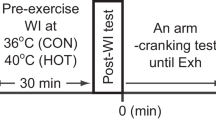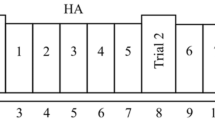Abstract
The present study was designed to find out if cooling and/or clothing affect the vertical trajectories and muscle function of the upper arm during repetitive light work. Twelve female subjects performed a one-handed lifting task for 60 min while standing in front of a table with six target angles (30° to 220°). The experiment was carried out in a climatic chamber in three different conditions: at 10°C (C), at 25°C (TN), and at 10°C dressed in cold-protective clothing (Cp). Skin and rectal temperatures were measured continuously. The vertical trajectories of the head, shoulder, elbow, and wrist on the right side of the body were recorded. Muscular strain (averaged EMG, a-EMG) and EMG gaps in eight muscles on the right upper arm were measured. The variation of the vertical trajectory amplitude of the upper arm measured from the elbow was significantly higher (at 200°) both at C and Cp (50 and 25% respectively) and in shoulder (at 220° angle) at C (33%) compared with TN (P < 0.05). Both C and Cp increased a-EMG and reduced the number and duration of EMG gaps significantly in all muscles studied. In conclusion, in repetitive tasks the high mean vertical trajectory and changes in the amplitude of the trajectory of the upper arm at C and Cp compared with TN were associated with increased muscular strain and reduced number of EMG gaps (more continuous activation of given muscle fibers). The changes in trajectories may serve as indicator of a risk for local muscle fatigue.



Similar content being viewed by others
References
Bonato P, Boissy P, Della Crose U, Roy S (2002) Changes in the surface EMG signal and biomechanics of motion during a repetitive lifting task. IEEE Trans Neural Syst Rehabil Eng 10(1):38–47. doi:10.1109/TNSRE.2002.1021585
Borg G (1998) Borg’s perceived exertion and pain scales. Human Kinetics, Champaign
Chen F, Li T, Huang H, Holmér I (1991) A field study of cold effects among cold store workers in China. Arctic Med Res 50(suppl 6):99–103
Chiang H, Chen S, Yu H, Ko Y (1990) The occurrence of carpal tunnel syndrome in frozen food factory employees. Kaohsiung J Med Sci 6:73–80
Coppin EG, Livinstone SD, Kuehn LA (1978) Effects of handgrip strength due to arm immersion in a 10°C water bath. Aviat Space Environ Med 49(11):1322–1326
Cote JN, Mathieu PA, Levin MF, Feldman AG (2002) Movement reorganization to compensate for fatigue during sawing. Exp Brain Res 146(3):394–398. doi:10.1007/s00221-002-1186-6
Enoka RM, Stuart DG (1992) Neurobiology of muscle fatigue. J Appl Physiol 72(5):1631–1648
Faulkner JA, Zerba E, Brooks SV (1990) Muscle of mammals: cooling impairs most functional properties. Am J Physiol Regul Integr Comp Physiol 259:R259–R265
Forestier N, Nougier V (1998) The effects of muscular fatigue on the coordination of a multijoint movement in human. Neurosci Lett 252(3):187–190. doi:10.1016/S0304-3940(98)00584-9
Hammarskjöld E, Harms-Ringdahl K, Ekholm (1992) Reproducibility of carpenters’ work after cold exposure. Int J Ind Ergon 9(3):195–204. doi:10.1016/0169-8141(92)90013-P
Hardy ID, Dubois EF (1938) The technical of measuring radiation and convection. J Nutr 15:461–475
Hilderbrandt VH, Bongerst PM, van Dijk FJH, Kemper HCG, Dul J (2002) The influence of climatic factors on non-specific back and neck-shoulder disease. Ergonomics 45(1):32–48. doi:10.1080/00140130110110629
Holewijn M, Heus R (1992) Effects of temperature on electromyogram and muscle function. Eur J Appl Physiol 65(6):541–545. doi:10.1007/BF00602362
ISO 9920 (1995) Ergonomics of thermal environment—estimation of the thermal insulation and evaporative resistance of clothing ensemble. ISO 9920:1995 (E), 1st edn. ISO, Geneva
ISO 10551 (1995) Ergonomics of the thermal environment—assessment of the influence of the thermal environment using subjective judgment scales. International Standards Organization, Geneva
Kurppa K, Viikari-Juntura E, Kousma E, Huuskonen M, Kivi P (1991) Incidence of tenosynovitis or peritendinitis and epicondylitis in meat-processing factory. Scand J Work Environ Heath 17(1):38–45
LeBlanc JS (1956) Impaired of manual dexterity in the cold. J Appl Physiol 9:62–64
Lotens WA (1989) The actual insulation of multilayer clothing. Scand J Work Environ Health 15(suppl 1):66–75
Mäkinen T, Rintamäki H, Korpelainen JT, Kamplan V, Pääkkönen T, Oksa J, Palinkas L, Leppäluoto J, Hassi J (2005) Postural sway during single and repeated cold exposures. Aviat Space Environ Med 76:947–53. doi:10.1002/ajhb.20627
McGorry RW, Hsiang SM, Snook SH, Clancy EA, Young SL (1998) Meteorological conditions and self-report of low back pain. Spine 23(19):2096–2102
Meigal AY, Oksa J, Hohtola E, Lupandin YV, Rintamäki H (1998) Influence of cold shivering on fine motor control in the upper limb. Acta Physiol Scand 163(1):41–47. doi:10.1046/j.1365-201x.1998.00333.x
Meinander H, Anttonen H, Bartels V, Holmér I, Reinertsen RE, Soltynski K, Varieras S (2004) Manikin measurements versus wear trials of cold protective clothing (Subzero project). Eur J Appl Physiol 92(6):619–621. doi:10.1007/s00421-004-1139
Mital A, Nicholson AS, Ayoub MM (1997) A guide to manual handling, 2nd edn. Taylor & Francis, London, p 70
Murray MM, Patton J, Mello R, Bidwell T, Harp M (2001) Energy cost of physical task performance in men and women wearing chemical protective clothing. Aviat Space Environ Med 72(1):25–31
Niedhammer I, Landre MF, Leclerc A, Bourgeois F, Franchi P, Chastang JF, Marignac G, Mereau P, Quinton D, Rondeau du Noyer C, Schmaus A, Vallayer C (1998) Shoulder disorders related to work organization and other occupational factors among supermarket cashiers. Int J Occup Environ Health 4(3):168–178
Nielsen R, Olesen BW, Fanger PO (1985) Effect of physical activity and air velocity on the thermal insulation of clothing. Ergonomics 28:1617–1632
Oksa J, Rintamäki H, Mäkinen T, Hassi J, Rusko H (1995) Cooling-induced changes in muscular performance and EMG activity of agonist and antagonist muscles. Aviat Space Environ Med 66:26–31
Oksa J, Rintamäki H, Rissanen S (1997) Muscle performance and electromyogram activity of the lower legs muscles with different levels of cold exposure. Eur J Appl Physiol 75(6):484–490. doi:10.1007/s004210050193
Oksa J, Ducharme M, Rintamäki H (2002) Combined effect of repetitive work and cold on muscle function and fatigue. J Appl Physiol 92:354–361
Petrofsky JS, Lind A (1980) The influence of temperature on the amplitude and frequency components of the EMG during brief sustained isometric contractions. Eur J Appl Physiol 44:189–200. doi:10.1007/BF00421098
Pope DP, Croft PR, Pritchard CM, Silman AJ, Macfarlane GJ (1997) Occupational factors related to shoulder pain and disability. Occup Environ Med 54(5):316–321
Resnik M (1996) Postural changes due to fatigue. Comput Ind Eng 31(1–2):491–494. doi:10.1016/0360-8352(96)00182-9
Rintamäki H (2005) Protective clothing and performance in cold environments. In: Proceeding of the third international conference on human–environment system, Tokyo, Japan, 12–15 September
Rissanen S, Rintamäki H (1997) Thermal responses and physiological strain in men wearing impermeable and semipermeable protective clothing in the cold. Ergonomics 40(2):141–150
Sargeant AJ (1987) Effect of muscle temperature on leg extension force and short-term power output in humans. Eur J Appl Physiol 56(6):693–698. doi:10.1007/BF00424812
Strasser H, Keller E (1989) Local muscular strain dependent on the direction of horizontal arm movements. Ergonomics 32(7):899–910. doi:10.1080/00140138908966852
Strasser H, Muller KW (1999) Favorable movements of the hand–arm system in horizontal plane assessed by electromyographic investigation and subjective rating. Int J Ind Ergon 23(4):339–347. doi:10.1016/S0169-8141(98)00050-X
Veiersted KB, Westgaard RH, Andersen P (1993) Electromyographic evaluation of muscular work pattern as a predictor of trapezius myalgia. Scand J Work Environ Health 19(4):284–290
Vincent MJ, Tipton MJ (1988) The effects of cold immersion and hand protection on grip strength. Aviat Space Environ Med 59:738–41
Voge KR, Dingwell JB (2003) Relative timing of change in muscular fatigue and movement coordination during a repetitive one-hand lifting task. In: Proceeding of the 25th annual international conference of the IEEE EMBS 2003. Cancun, Mexico, 17–21 September
Winkel J, Jørgensen K (1991) Significance of skin temperature changes in surface electromyography. Eur J Appl Physiol 63:345–348. doi:10.1007/BF00364460
Author information
Authors and Affiliations
Corresponding author
Rights and permissions
About this article
Cite this article
Piedrahita, H., Oksa, J., Malm, C. et al. Effects of cooling and clothing on vertical trajectories of the upper arm and muscle functions during repetitive light work. Eur J Appl Physiol 104, 183–191 (2008). https://doi.org/10.1007/s00421-007-0657-7
Accepted:
Published:
Issue Date:
DOI: https://doi.org/10.1007/s00421-007-0657-7




